The history of the Jews in Colonial America begins upon their arrival as early as the 1650s. The first Jews that came to the New World were Sephardi Jews who arrived in New Amsterdam. Later major settlements of Jews would occur in New York, New England, and Pennsylvania.

Oakland Cemetery is one of the largest cemetery green spaces in Atlanta, Georgia, U.S. Founded as Atlanta Cemetery in 1850 on six acres (2.4 hectares) of land southeast of the city, it was renamed in 1872 to reflect the large number of oak and magnolia trees growing in the area. By that time, the city had grown and the cemetery had enlarged correspondingly to the current 48 acres (190,000 m2). Since then, Atlanta has continued to expand so that the cemetery is now located in the center of the city. Oakland is an excellent example of a Victorian-style cemetery, and reflects the "garden cemetery" movement started and exemplified by Mount Auburn Cemetery in Massachusetts.
The history of Jews in Charleston, South Carolina, was related to the 1669 charter of the Carolina Colony, drawn up by the 1st Earl of Shaftesbury and his secretary John Locke, which granted liberty of conscience to all settlers, and expressly noted "Jews, heathens, and dissenters". Sephardi Jews from London were among the early settlers in the city and colony, and comprised most of its Jewish community into the early 1800s.

Mikveh Israel Cemetery is the oldest Jewish cemetery in Philadelphia, Pennsylvania, giving evidence of a settled community as early as 1740. A number of outstanding patriots, pioneers, and other notables of the Jewish faith who made important contributions to the history and freedom of America during the Colonial and Revolutionary period were interred here, and for this reason, in 1959, by an act of Congress, the burial ground was designated as a unit of the Independence National Historical Park, while continuing to be maintained by the sponsoring Congregation Mikveh Israel. The cemetery was certified by the Philadelphia Historical Commission, and in 1971, it was listed on the National Register of Historic Places.
Malaysian Jews are Jews living in Malaysia, whether immigrants or those originally from the country. The state of Penang was once home to a Jewish community, until the latter part of the 1970s, by which time most had emigrated due to growing state-sanctioned antisemitism. Indications of the growing racial and religious hostility in the nation has caused many Malaysian Jews to leave or flee the country. The Malaysian Jewish community consists of Jews of Sephardic origin who live discreetly amongst the Kristang people (Malacca-Portuguese), Mizrahi Jews, Malabar Jews and Ashkenazi Jews.
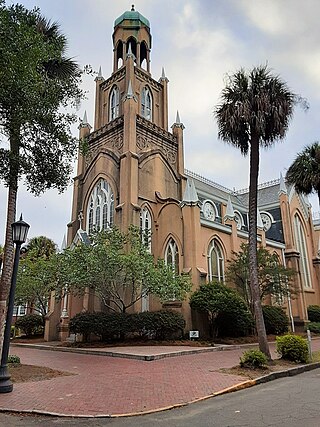
Congregation Mickve Israel in Savannah, Georgia, is one of the oldest synagogues in the United States, as it was organized in 1735 by mostly Sephardic Jewish immigrants of Spanish-Portuguese extraction from London who arrived in the new colony in 1733. They consecrated their current synagogue, located on Monterey Square in historic Savannah, in 1878. It is a rare example of a Gothic-style synagogue. The synagogue building was listed on the National Register of Historic Places in 1980. Today, the synagogue is a member of the Union for Reform Judaism.
Samuel Nunes (1668–1744) was a Portuguese physician and among the earliest Jews to settle in North America.

Temple Beth Elohim is a Reform synagogue located at 230 Screven Street in Georgetown, South Carolina.
Mordecai Sheftall was a Georgia merchant who served as a colonel in the Continental Army during the American Revolutionary War and was the highest ranking Jewish officer of the Colonial forces. He was born in Savannah, Province of Georgia, to Benjamin and Perla Sheftall, who had arrived in 1733 to the Georgia colony on the William and Sarah from London, England, with a few dozen members of other Jewish immigrant families. The Sheftalls were founding among the members of Congregation Mickve Israel.
Simeon Magruder Levy, also known as Simon Levy, was an officer in the United States Army. He was the second overall graduate and first Jewish graduate of the United States Military Academy.

The Levi Sheftall Family Cemetery, also known as the de Lyon-De La Motta Cemetery or Cohen Street Cemetery, is a historic cemetery in Savannah, Georgia, United States. Located in the Kayton/Frazier area of West Savannah, it is the burial ground for members of the Sheftall, de Lyon, and De La Motta families. The cemetery was established by Levi Sheftall in 1765.

Bull Street is a major street in Savannah, Georgia, United States. Named for Colonel William Bull (1683–1755), it runs from Bay Street in the north to Derenne Avenue in the south. It is around 3.40 miles in length, not including the section interrupted by Forsyth Park. It is the center of a National Historic Landmark District.
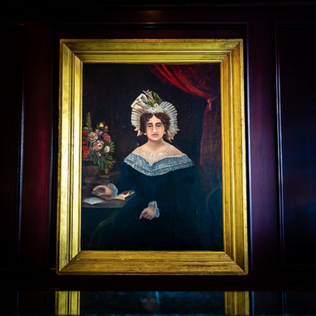
Mary Magdalene Marshall was an American real-estate investory and philanthropist. She established The Marshall House hotel in Savannah, Georgia, and had erected in the city several notable buildings that are still standing today.
Abraham Minis was a European immigrant to the newly settled colony of Savannah, Province of Georgia, in 1733. Despite their not knowing if they would be received, General James Oglethorpe, founder of the Savannah colony, allowed him and his family entry and granted them land. Their descendants have lived in Savannah ever since.

Abigail Minis was a businesswoman and landowner, prominent in Savannah, Province of Georgia, during the American Revolutionary War. She was a European immigrant, along with her husband, Abraham Minis, to the newly settled colony of Savannah, in 1733. Despite their not knowing if they would be received, General James Oglethorpe, founder of the colony, allowed her and her family entry and granted them land.
Philip Minis was an American merchant, and the first white male born in the colony of Savannah, Province of Georgia. He went on to become paymaster to the Continental Army in Georgia during the American Revolutionary War, in addition to being an advisor to French and continental forces. His name appears in the Journals of the Continental Congress.
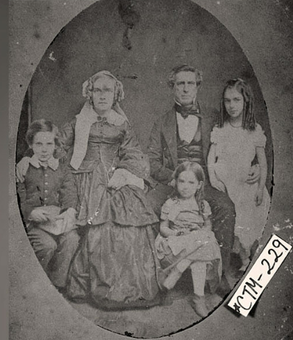
Solomon Cohen Jr. was a lawyer, prominent in Savannah, Georgia, where he was also postmaster, the state's first Jewish senator, a district attorney, a real-estate developer and banker. He established the first Jewish Sunday School in Georgia.
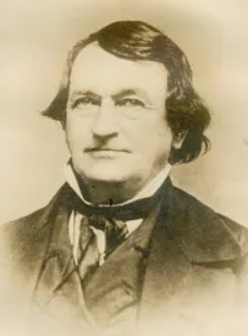
Mordecai Myers was an American politician and landowner in Savannah, Georgia, in the 19th century.
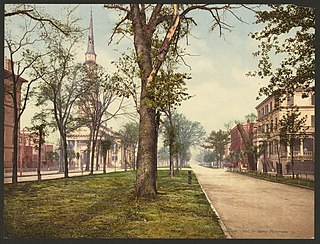
Oglethorpe Avenue is a prominent street in Savannah, Georgia, United States. Located, in its downtown section, between York Street to the north and Hull Street to the south, it runs for about 1.26 miles (2.03 km) from the Atlantic Coastal Highway in the west to Randolph Street in the east. It was originally known as South Broad Street, then Market Street. After being named South Broad Street again for a period, it became known as Oglethorpe Avenue in 1897. It was formerly Oglethorpe Avenue singular, but its addresses are now split between "West Oglethorpe Avenue" and "East Oglethorpe Avenue", the transition occurring at Bull Street in the center of the downtown area. The street is named for the founder of the Savannah colony, James Edward Oglethorpe.
Bull Street Cemetery was a Jewish cemetery established in Savannah, Province of Georgia, in 1733. Today, a memorial in the median of West Oglethorpe Avenue, at Bull Street, erected in 1983 by the trustees of the Mordecai Sheftall Cemetery, marks the former location of the cemetery, which contained around twenty graves when it was built over around a century after it opened. The memorial says: "Original 1733 burial plot allotted by James Edward Oglethorpe to the Savannah Jewish Community."












